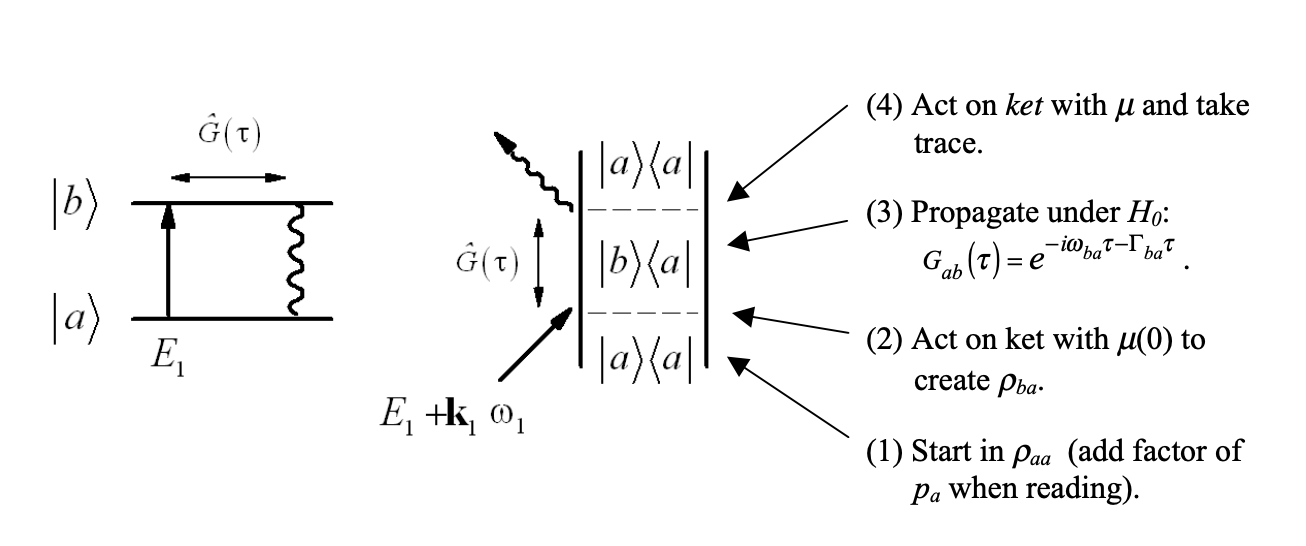2.3: Example-Linear Response for a Two-Level System
- Page ID
- 298955
Let’s consider the diagrammatic approach to the linear absorption problem, using a two-level system with a lower level \(a\) and upper level \(b\). There is only one independent correlation function in the linear response function
\[\begin{aligned} C(t) &= Tr[\mu(t)\mu(0)\rho_{eq}] \\[4pt] &=Tr[\mu\hat G(t)\mu\rho_{eq}]\end{aligned}\label{3.3.1}\]
This does not need to be known before starting, but is useful to consider, since it should be recovered in the end. The system will be taken to start in the ground state \(\rho_{aa}\). Linear response only allows for one input field interaction, which must be absorption, and which we take to be a ket side interaction. We can now draw two diagrams:

With this diagram, we can begin by describing the signal characteristics in terms of the induced polarization. The product of incident fields indicates:
\[E_1e^{-i\omega_1t+i\bar k_1\cdot\bar r} \Rightarrow P(t)e^{-i\omega_{sig}t+i\bar k_{sig}\cdot\bar r}\label{3.3.2}\]
so that
\[\omega_{sig}=\omega_1 ~~~~~ \bar k_{sig}=\bar k_1 \label{3.3.3}\]
As expected the signal will radiate with the same frequency and in the same direction as the incoming beam. Next we can write down the correlation function for this term. Working from bottom up:
(1) (2) (3) (4)
\[\begin{aligned} C(t) &=p_{a}\left[\mu_{b a}\right]\left[e^{-i \omega_{b a} t-\Gamma_{b a} t}\right]\left[\mu_{a b}\right] \\
&=p_{a}\left|\mu_{b a}\right|^{2} e^{-i \omega_{b a} t-\Gamma_{b a} t} \end{aligned} \label{3.3.4}\]
More sophisticated ways of treating the time-evolution under \(H_0\) in step (3) could take the form of some of our earlier treatments of the absorption lineshape:
\[\begin{aligned}\hat{G}(\tau) \rho_{a b} & \sim \rho_{a b} \exp \left[-i \omega_{a b} \tau\right] F(\tau) \\&=\rho_{a b} \exp \left[-i \omega_{a b} \tau-g(t)\right] \end{aligned} \label{3.3.5}\]
Note that one could draw four possible permutations of the linear diagram when considering bra and ket side interactions, and initial population in states a and b:

However, there is no new dynamical content in these extra diagrams, and they are generally taken to be understood through one diagram. Diagram ii is just the complex conjugate of eq. (3.3.4) so adding this signal contribution gives:
\[C(t)-C^*(t)=2ip_a|\mu_{ba}|^2\sin (\omega_{ba}t)e^{-\Gamma_{ba}t} \label{3.3.6}\]
Accounting for the thermally excited population initially in b leads to the expected two-level system response function that depends on the population difference
\[R(t)=\frac{2}{\hbar}(p_a-p_b)|\mu_{ba}|^2\sin (\omega_{ba}t)e^{-\Gamma_{ba}t} \label{3.3.7}\]


